You are using an out of date browser. It may not display this or other websites correctly.
You should upgrade or use an alternative browser.
You should upgrade or use an alternative browser.
Growing plants up house walls
- Thread starter Hobden
- Start date
JoceAndChris
Member
- Messages
- 6,606
- Location
- Lincolnshire
I like plants up walls. Ivy has aggressive brick crumbling roots though, you don't want that! Nicely mounted trellis and a Virginia creeper looks nice! Clematis and honeysuckle too. Lovely. I'd do it on cement render, not on lime render though.
Trees and high hedges are good for sheltering buildings too. We have a thick high wall of holly that offers a lot of protection.
Ivy has smashed up our Georgian brick ha ha in many places as well as sheltering it from rain. But on the whole not good.
Trees and high hedges are good for sheltering buildings too. We have a thick high wall of holly that offers a lot of protection.
Ivy has smashed up our Georgian brick ha ha in many places as well as sheltering it from rain. But on the whole not good.
Hmm, not such a fan here. About 20 years someone planted a clematis montana on the rear corner of our Edwardian house. By the time we moved in, it was all over two sides of the house, rampaging over the top of the bay window, blocking up all our lovely timber gutters and trying to find a way under the roof tiles. It's now been cut down to 6 ft and will be out entirely if I can't keep it under control. Some clematis varieties are lovely and well-behaved, but montana is not one of them. Near neighbours have what looks like climbing hydrangea on the front of their house and again it has taken over and is clambering over some of their windows.
On the other hand, another neighbour in a Victorian villa has a tightly trained wisteria that looks fantastic in flower. She manages it with a rod of iron (or at least a weekly trim).
So I think for me, choose your climber carefully, train it well and don't let it get the upper hand. If in doubt, don't.
On the other hand, another neighbour in a Victorian villa has a tightly trained wisteria that looks fantastic in flower. She manages it with a rod of iron (or at least a weekly trim).
So I think for me, choose your climber carefully, train it well and don't let it get the upper hand. If in doubt, don't.
Well, everybody says this, but I've had ivy for twenty odd years and my old, soft, bricks still seem fine! It makes a nice fedge too (combination fence/hedge) for screening/windbreak purposes. That said, it can be rampant and when one of fedges finally came down ("hurricane" Kate) I was chopping out ivy stalks thicker than my leg!JoceAndChris said:Ivy has aggressive brick crumbling roots though, you don't want that!
Yup, that's what we've got. Though I used plastic-coated green wire wrapped around brass screws to give the C+H something to twine around.JoceAndChris said:Nicely mounted trellis and a Virginia creeper looks nice! Clematis and honeysuckle too. Lovely.
Because lime is softer and more easily damaged? Or it'd get in the way of periodic rewashing?JoceAndChris said:I'd do it on cement render, not on lime render though.
Did that too! It can be howling a gale and still relatively calm in our garden. I'm already, mentally, planning my planting for any new place we get. If we get one, sigh.JoceAndChris said:Trees and high hedges are good for sheltering buildings too.
Yup, been there, done that, when I was young and green. I only grow the low-growing varieties up walls now, though I find you can usually double whatever size the label gives as maximum height!JBean said:Hmm, not such a fan here. About 20 years someone planted a clematis montana on the rear corner of our Edwardian house. By the time we moved in, it was all over two sides of the house, rampaging over the top of the bay window, blocking up all our lovely timber gutters and trying to find a way under the roof tiles.
Do you want to lose your house? Want to hide it from the pesky authorities for some reason? Seeking a real jungle look in the middle of the urban jungle? Then plant a Russian vine somewhere near your house. In a couple of years you'll have given up the machete you needed to reach the front door, and you've be living in a tent in the garden!
jocelyn plummer
Member
- Messages
- 2,297
- Location
- North Norfolk
I have one word only for this thread----Wisteria --------- perfectimo
jocelyn plummer said:I have one word only for this thread----Wisteria --------- perfectimo
Seconded
Will try to find some piccies of ours here and post on the morrow :wink:
Some piccies of the wisteria we inherited when we bought our current house.......
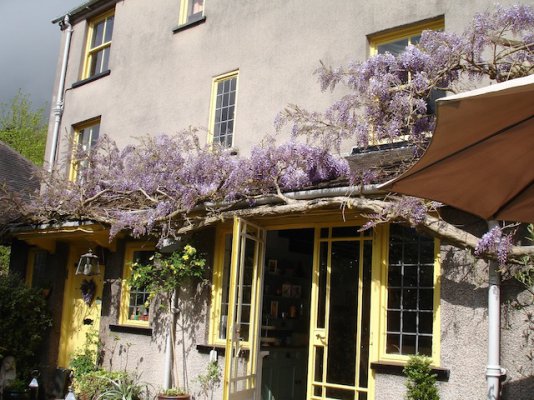
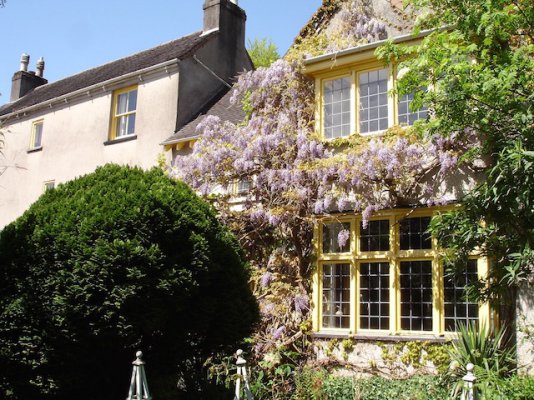
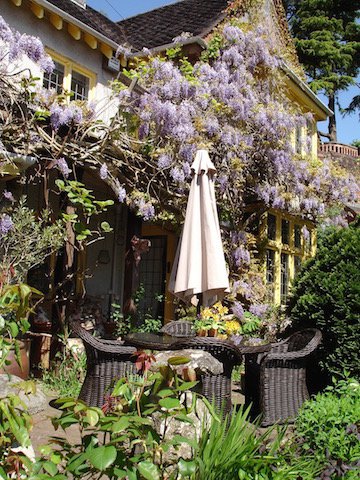
These were taken in Spring 2015 - before I began the laborious task of removing all trace of the yellow paint, lol :lol:
We understand it was planted in around 1924 when the house was extended (the two-storey bay end). At around 60' in length, it is a bit of a beast and has caused the balcony railings (timber) to collapse where it has wound itself around them over the years - mainly as a result of neglect by the previous owner - so does need keeping under strict control :roll:
Mims x



These were taken in Spring 2015 - before I began the laborious task of removing all trace of the yellow paint, lol :lol:
We understand it was planted in around 1924 when the house was extended (the two-storey bay end). At around 60' in length, it is a bit of a beast and has caused the balcony railings (timber) to collapse where it has wound itself around them over the years - mainly as a result of neglect by the previous owner - so does need keeping under strict control :roll:
Mims x
88v8
Member
- Messages
- 3,129
- Location
- Glorious Gloucs
Climbers integrate the house into the garden.
All climbers need suitable support in the case of those not self-clinging, initial training and ongoing maintenance. Some owners don't bother to learn how to prune them or when, then blame the plant for doing what comes naturally, which is climbing upwards.
Petiolaris - climbing hydrangea - is great on a north wall. Left unchecked and with a moist root run, it can grow to 100ft, but it clothed the north wall of our previous house for 30 years. I pruned it in the correct manner at the appropriate time.
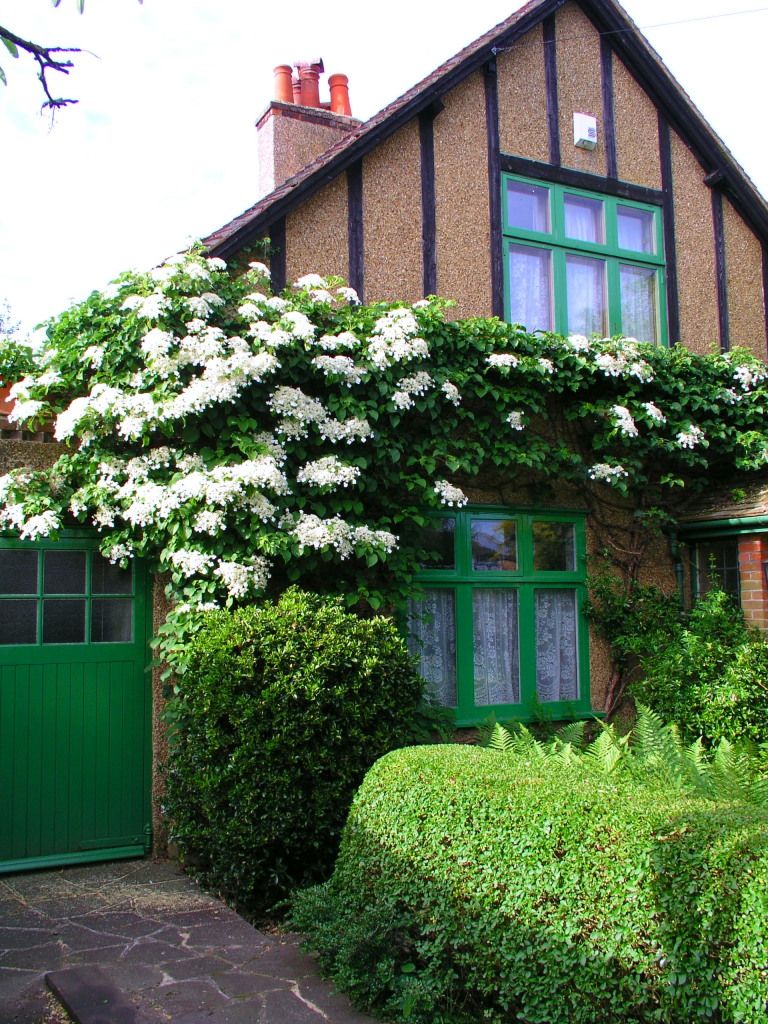
Ivy.. we planted Goldheart on the back (south). Left alone it would have been on the roof and up the chimney, but I pruned it twice a year. Even though it was on a wall over the glazed conservatory roof. I stood on the roof, and put a ladder on the roof.
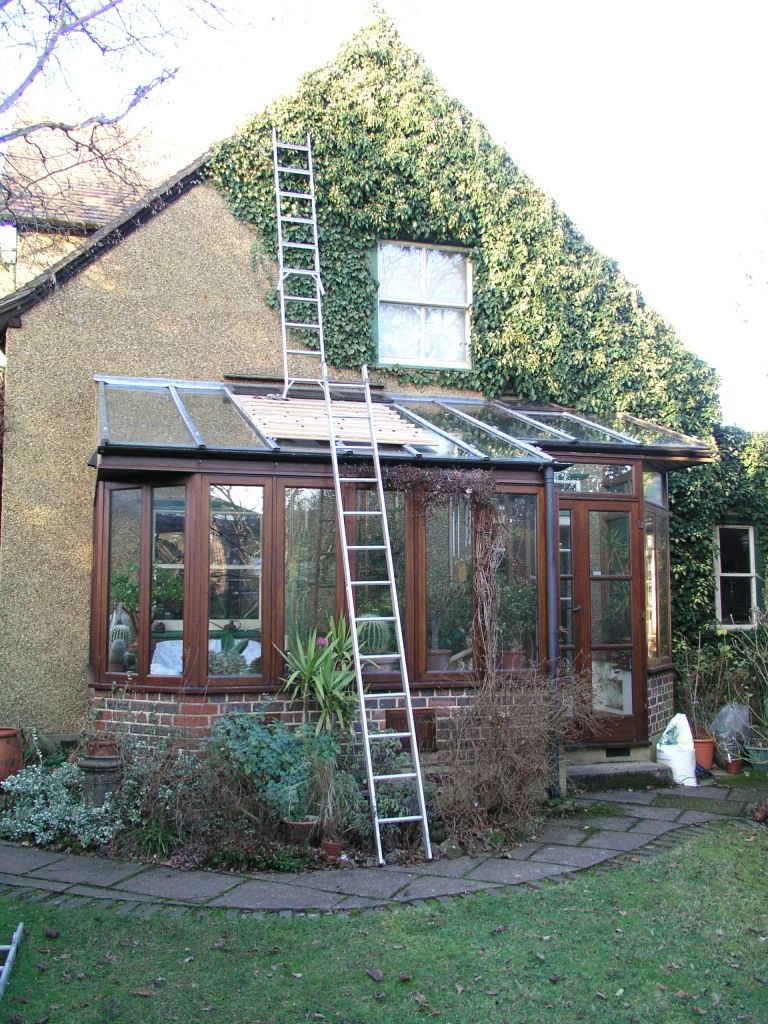
Ivy waterproofs the wall. It shades the wall from the sun - the sun is a great destroyer. It provides an insect and bird habitat, and its flowers are an important source of autumn nectar. The ivy prevented recurrence of the thermal-gain cracking that had historically occurred at the ends of the lintels. I deliberately trained it sideways across the wall for that purpose.
It also protected the garage parapet from heat gain, and the upstand of the garage asphalt roof.
Here, there is a huge old Montana on the east end. I prune it at the appropriate times so as not to prune away next year's flowers. I do not allow it on the thatched roof. It is beautiful in flower and scent.
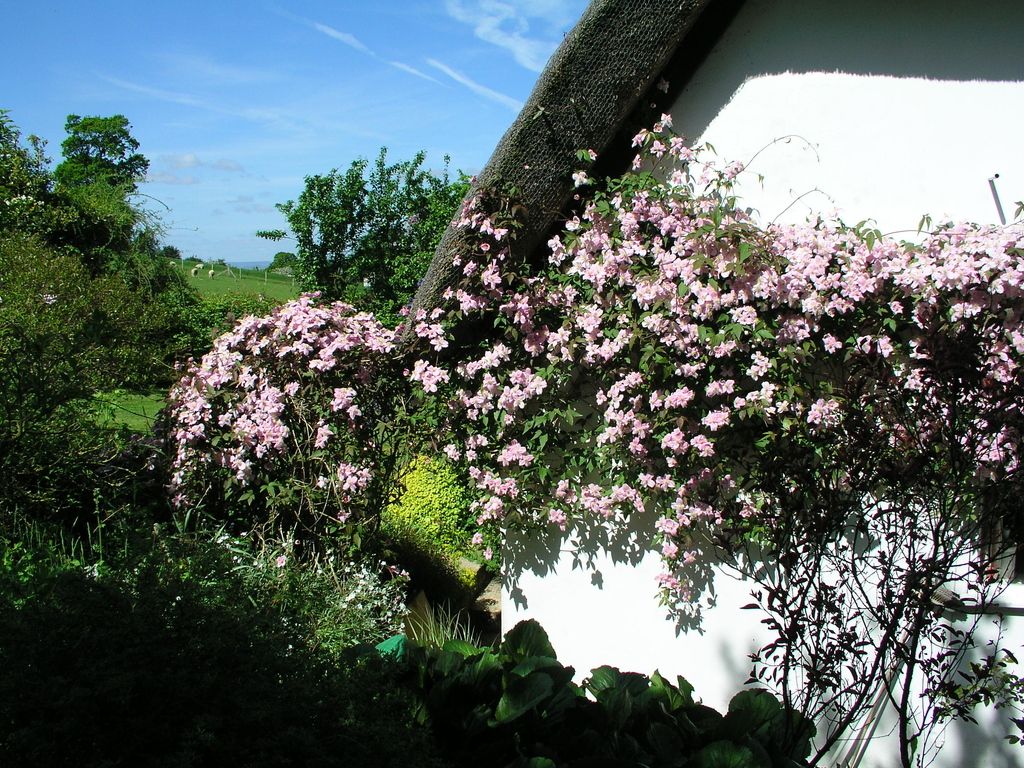
I should extend the training wires upwards, then it would have more scope.
I would not plant self-supporting climbers on a wall that needs limewashing. Nor would I plant ivy or petiolaris on an unsound wall as they will grow into cracks and lever them apart. Nor over timber or wattle panels. Never allow them to climb on the roof, they will grow into dark spaces and crack the tiles.
If a climber can be grown on a trellis, the trellis can be hinged at the bottom to facilitate maintenance of the wall. This has its limitations. A very old climber will eventually become too woody to tolerate bending, but this will take many years.
Never had wistaria. It can be superb, if correctly trained and pruned.
Climbers are rather like dogs. If they misbehave, blame the owner.
Ivor
All climbers need suitable support in the case of those not self-clinging, initial training and ongoing maintenance. Some owners don't bother to learn how to prune them or when, then blame the plant for doing what comes naturally, which is climbing upwards.
Petiolaris - climbing hydrangea - is great on a north wall. Left unchecked and with a moist root run, it can grow to 100ft, but it clothed the north wall of our previous house for 30 years. I pruned it in the correct manner at the appropriate time.

Ivy.. we planted Goldheart on the back (south). Left alone it would have been on the roof and up the chimney, but I pruned it twice a year. Even though it was on a wall over the glazed conservatory roof. I stood on the roof, and put a ladder on the roof.

Ivy waterproofs the wall. It shades the wall from the sun - the sun is a great destroyer. It provides an insect and bird habitat, and its flowers are an important source of autumn nectar. The ivy prevented recurrence of the thermal-gain cracking that had historically occurred at the ends of the lintels. I deliberately trained it sideways across the wall for that purpose.
It also protected the garage parapet from heat gain, and the upstand of the garage asphalt roof.
Here, there is a huge old Montana on the east end. I prune it at the appropriate times so as not to prune away next year's flowers. I do not allow it on the thatched roof. It is beautiful in flower and scent.

I should extend the training wires upwards, then it would have more scope.
I would not plant self-supporting climbers on a wall that needs limewashing. Nor would I plant ivy or petiolaris on an unsound wall as they will grow into cracks and lever them apart. Nor over timber or wattle panels. Never allow them to climb on the roof, they will grow into dark spaces and crack the tiles.
If a climber can be grown on a trellis, the trellis can be hinged at the bottom to facilitate maintenance of the wall. This has its limitations. A very old climber will eventually become too woody to tolerate bending, but this will take many years.
Never had wistaria. It can be superb, if correctly trained and pruned.
Climbers are rather like dogs. If they misbehave, blame the owner.
Ivor
MatthewC
Member
- Messages
- 1,769
- Location
- Central/South England
There was a huge amount of ivy on the front of my house, up to the slate roof, inside the loft, blocking windows, splitting gutter joints etc, and I was amazed that it had only penetrated the limestone wall in one place (below ground); the entire wall was in lovely condition having been protected by the thick ivy. However, the ivy on the similar garden wall was recently removed (by my neighbour) and this has revealed a wall that needs to largely rebuilt - there are many roots which have penetrated and basically there now is very little mortar on the top three feet of the wall, and lots of loose stones.JoceAndChris said:I like plants up walls. Ivy has aggressive brick crumbling roots though, you don't want that!
I remain convinced, as I put on my blog almost six years ago - Ivy Is The Enemy http://houseintheenchantedforest.blogspot.co.uk/2011/03/ivy-is-enemy-and-fun-with-joists.html!
CliffordPope
Member
- Messages
- 1,023
I've seen buildings destroyed by ivy. It can force its way through soft mortar in between stones and then just expands. Ivy stems can grow more than 3" thick. You can end up with a draughty cage with gaps in the walls, the stones or chunks of brick only held in place by the very ivy that has pulled them apart.
If it gets into the roof it can force the slates off.
If it gets into the roof it can force the slates off.
Mrs H likes it, but I'm not so much of a fan as I think the woody stems too dominant.pip&mims said:Some piccies of the wisteria we inherited when we bought our current house.......
Hear, hear!88v8 said:Climbers integrate the house into the garden.
Hadn't thought of that, useful suggestion, thanks.88v8 said:Petiolaris - climbing hydrangea - is great on a north wall. Left unchecked and with a moist root run, it can grow to 100ft, but it clothed the north wall of our previous house for 30 years.
Waterproofing, definitely, it's why I planted it here. Sun - hadn't considered the effects of that I must admit. I also assume that (big) plants against a wall will help keep the base of the wall dry (probably especially important with a cob wall), though no doubt there's a balance to strike between dry and too dry.88v8 said:Ivy waterproofs the wall. It shades the wall from the sun - the sun is a great destroyer.
Another useful tip, thanks. Maybe I will be able to grow stuff up a limewashed wall (if we obtain such)88v8 said:If a climber can be grown on a trellis, the trellis can be hinged at the bottom to facilitate maintenance of the wall. This has its limitations. A very old climber will eventually become too woody to tolerate bending, but this will take many years.
JoceAndChris
Member
- Messages
- 6,606
- Location
- Lincolnshire
Beautiful piccies above. Nice to see people's homes such a pride and joy. Thanks for sharing Mims and Ivor.
I love the wisteria but is it enough? May time when the whole garden is bursting with blossom! Then that often flower less back end of summer, and autumn, winter. I'm not negating its value but interest has to be planned for those more boring months. Topiary along the base of the house has a lot going for it! Year round interest and architectural ornamentation.

For me the climber is almost taking away from the strong architectural lines there in Roy Strong's Laskett gardens.
I love the wisteria but is it enough? May time when the whole garden is bursting with blossom! Then that often flower less back end of summer, and autumn, winter. I'm not negating its value but interest has to be planned for those more boring months. Topiary along the base of the house has a lot going for it! Year round interest and architectural ornamentation.

For me the climber is almost taking away from the strong architectural lines there in Roy Strong's Laskett gardens.
malcolm
& Clementine the cat
- Messages
- 1,888
- Location
- Bedfordshire
I'm not a great fan of growing plants up walls - they need regular maintenance. Below is a picture of my barn when I bought the house. The shrub is still there and softens the stark gable, but is now trimmed once a year at a height that does not require a ladder. (Or should be - I forgot this year and it is reaching roof height.) Avoid Ivy - it seems impossible to kill.
Across the road there is a building called Wisteria House for obvious reasons. They are quite often trimming their wisteria when I go to the shop to buy my milk on a Sunday - it is pretty but a lot of work.
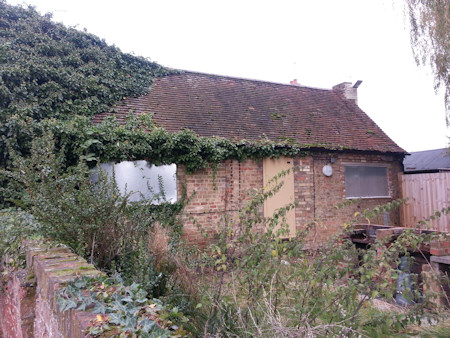
Across the road there is a building called Wisteria House for obvious reasons. They are quite often trimming their wisteria when I go to the shop to buy my milk on a Sunday - it is pretty but a lot of work.

I find one of these v. useful - https://www.henchman.co.uk/products/hi-step-platforms.htmlmalcolm said:but is now trimmed once a year at a height that does not require a ladder. (Or should be - I forgot this year and it is reaching roof height.)
And I'm sure there are many other makes and models. It's all too easy to fall off a ladder, especially as after five minutes up one it's easy to forget where you are and next thing you know you're standing on one leg to reach out sideways to get "just one more bit". Mrs H used to shudder (I was at least sensible enough to get her to stand on the bottom of the ladder).
Ivor, both your current and previous gardens look lovely......thank you for posting 
Joce, thank you for drawing my attention to Laskett Gardens, which I had heard of but wasn't aware they are only about 1 hr 15 from here........a must see, I think We did visit Wollerton Old Hall gardens in Shropshire last year - stunning again, will hunt out a few piccies! We are also fortunate to be a short drive to the David Austen nursery and garden at Albrighton......as you'd expect there were swoon-worthy displays of roses when we popped along a few months ago.
We did visit Wollerton Old Hall gardens in Shropshire last year - stunning again, will hunt out a few piccies! We are also fortunate to be a short drive to the David Austen nursery and garden at Albrighton......as you'd expect there were swoon-worthy displays of roses when we popped along a few months ago.
Topiary is one of my favourite garden styles and I'd love to do a whole topiary garden one day, but for now my few box balls and one spiral box will have to suffice! You're right about the anti climax after the wisteria has died back - there is a relatively mature kiwi vine that grows up through it, but whilst the blooms are quite stunning and being a foliage-lover the leaves appeal to me, again the flowering time is relatively short. We also inherited a Virginia Creeper, but sadly we lost that this year......
In addition we have a few clematis, honeysuckles and roses rambling over the walls of the house, but nothing to rival the wisteria :roll:
I do like Ivy - but am quite wary of letting it get anywhere near masonry/brickwork and certainly wouldn't want it on a line rendered wall! At our last house there was rampant Ivy growing up the gable end, heading towards the recently thatched roof. That was quickly removed :wink:
Mims x
Joce, thank you for drawing my attention to Laskett Gardens, which I had heard of but wasn't aware they are only about 1 hr 15 from here........a must see, I think
Topiary is one of my favourite garden styles and I'd love to do a whole topiary garden one day, but for now my few box balls and one spiral box will have to suffice! You're right about the anti climax after the wisteria has died back - there is a relatively mature kiwi vine that grows up through it, but whilst the blooms are quite stunning and being a foliage-lover the leaves appeal to me, again the flowering time is relatively short. We also inherited a Virginia Creeper, but sadly we lost that this year......
In addition we have a few clematis, honeysuckles and roses rambling over the walls of the house, but nothing to rival the wisteria :roll:
I do like Ivy - but am quite wary of letting it get anywhere near masonry/brickwork and certainly wouldn't want it on a line rendered wall! At our last house there was rampant Ivy growing up the gable end, heading towards the recently thatched roof. That was quickly removed :wink:
Mims x
jocelyn plummer
Member
- Messages
- 2,297
- Location
- North Norfolk
Wisteria has a beautiful knarled branch and trunk system which is revealed after flowering----that is, if one can wait long enough for the branches to thicken--takes a few years!!
overlander matt
Member
- Messages
- 405
The weather was too nice today to spend indoors pulling up floor boards and removing old pipework. Time to go outside...
We have inherited a garden with a good number of mature plants including a few climbers. The walls of the walled garden were thick with ivy and it has caused some damage. Having spent a few days pulling out as much down as I can, I think careful management will be needed in future. I certainly won't let them get covered again.
We have a large Climbing Hydrangea at the back of the house that looks a bit out of control. The next step will be some pruning (probably to keep it within the confines of one wall) but is this plant likely to cause any trouble? I see Ivor has one at his place. There is also a Wisteria but as far as I know it has never flowered. I will need to read up about pruning...
I could be up the ladder tomorrow with the secateurs!
We have inherited a garden with a good number of mature plants including a few climbers. The walls of the walled garden were thick with ivy and it has caused some damage. Having spent a few days pulling out as much down as I can, I think careful management will be needed in future. I certainly won't let them get covered again.
We have a large Climbing Hydrangea at the back of the house that looks a bit out of control. The next step will be some pruning (probably to keep it within the confines of one wall) but is this plant likely to cause any trouble? I see Ivor has one at his place. There is also a Wisteria but as far as I know it has never flowered. I will need to read up about pruning...
I could be up the ladder tomorrow with the secateurs!

